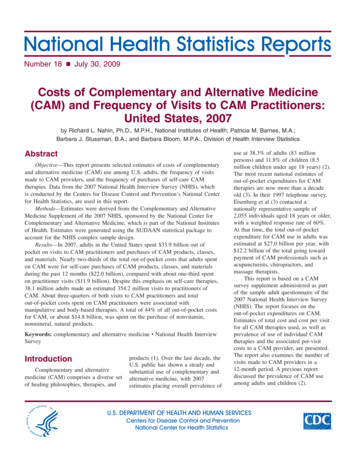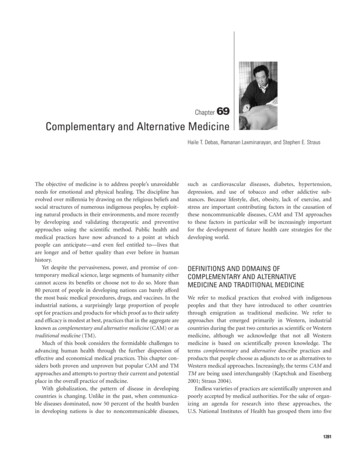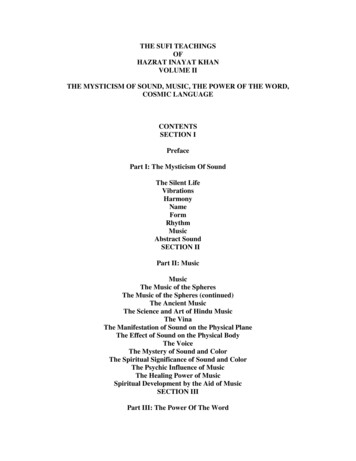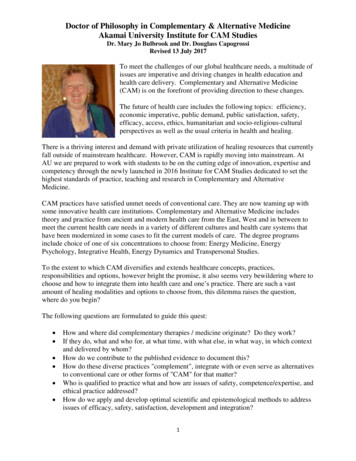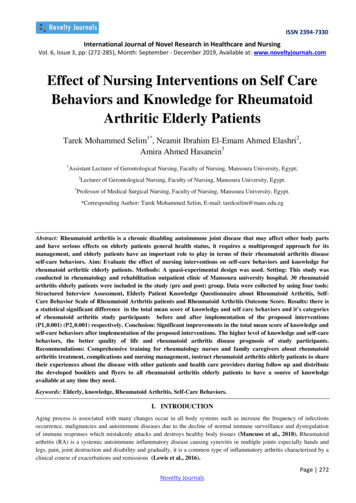
Transcription
ComplementaryInterventions inPregnancyNatural Healing in Pregnancy
First of all . First and for most – Over time, one cannot outpace thenegative results of poor diet, exposure to toxins, stressand lifestyle choices, which can contribute to commoncomplaints of pregnancy. Whenever possible, alsopursue root causes. I have no conflicts of interest to report. Any specificproducts mentioned are those mentioned from researchstudies, may be commonly used, or my personal opinion2/2 to my thoughts concerning fewer added inertchemicals, and history and or reputation in the marketplace and usage by respected colleagues.
Objectives Understand some of the motivations among clients forthe use of complementary therapies Understand classes of herbs that are contraindicated inpregnancy. Understand risks and benefits of discussedcomplementary substances used in common issues ofpregnancy Have and awareness of some common doses foralternative substances in pregnancy Find evidence based sources for herbal safetyinformation
Why women seekcomplementary therapies Globally, it is estimated that70% of all health care isprovided by traditional,NONconventional medicine. 50-80% of all Americans haveused CAM therapies Aveerage USA CAM users arewomen 30-59, well educatedwith incomes 50000/year Desiring prevention of chronicdiseases via education, goodnutrition, and safe nutritionalsupplements (also concernedwith the safety of manypharmaceuticals)
Potential Pregnancy Comparisons(the black and white versions)Medical ModelHolistic model Woman is encouraged to be The goal is to assist the Mother and baby are separate The mother and baby are a The woman’s body is a The woman’s body is a well- Power and authority are handed The woman maintains powerdependent and is treated aspotentially ill and in a abnormalstatepatients whose medical andemotional needs can conflict;the mother’s emotional needsmay jeopardize the baby’shealthmechanical organism that needsfixingover to the institution.woman toward self-care as ahealthy person in a state ofnormalcyunit whose medical andemotional needs arecomplementary; what meetsthe needs of one meets theneeds of bothfunctioning home for herselfand her babyand authority over herself.
Potential Pregnancy Comparisons(the black and white versions)Holistic modelMedical Model Responsibility is assumed bythe provider; needs andworkings are best known byhim/her. The emphasis is on pregnancyand birth as times of stress anddanger. Childbirth is seen as anoccasion for the provision ofmedical services The provider manages the careof the woman Childbirth is seen as a surgicalprocedure performed on thepelvic region of a woman,involving the removal of a fetusand a placenta Responsibility is in the hands ofthe woman, shared by theprovider. Needs are best known bythe woman herself. The emphasis is on pregnancyand birth as times ofphysical/psychological/emotionalgrowth for the mother and fetus Childbirth is seen as an activity inwhich the healthy woman engages The provider guides and educatesthe women during her experience. Childbirth is seen as an event inthe lives of the woman and herfamily. The woman’s active birthgiving is enhanced by education,support, and skilled care
Medical and herbalsubstances classification Herbs are classified differently than medications. Organizationssuch as the American Herbal Pharmacopoea (AHP or may bedesignated AHPA), the German Commission E, and the EuropeanScientific Cooperative on Phytotherapy (ESCOP), and the WorldHealth Organization (WHO) are respected organizations thatevaluate herbal safety and produce monographs describingherbal safety. Classifications of herbs are based on the use of the herb itselfbeing consumed (simple chart front of APH book). Use of theseclassifications still requires some knowledge, as to appropriateuse in pregnancy and/or lactation, childhood, or specific diseaseprocesses) Keep in mind that, typically herbal medicines are made fromplant parts, the active chemicals are not extracted and isolated fortheir specific activity. It often takes time and/or repetitive intaketo see results. They are often combined together in extracts,tinctures, or teas for synergistic properties – example: lavender milky oats lemon balm for stress and relaxation before bed
Medical and herbalsubstances classificationPharmacological(changing)Herbal
Most of the time, in pregnancy, we are going to typically recommendstandard of care for the community (narrowly and broadly) we serve.However, many women will decline standard of care or will present, statingthey are taking something that may (or may not) be a reasonably safealternative.Up to 60% of pregnant women will use some form ofalternative/complementary medicine during pregnancy. Some will assumethat something that may be considered safe in other seasons of life is also OKin pregnancy. (examples include culinary herbs used in Most culinary herbsmay be OK in culinary doses – ex oregano in spaghetti sauce or sage inThanksgiving dressing, but not EOs, tinctures, teas or capsules.)Minimize exposure to many herbs and alternative treatments to thoseneeded, especially in the first trimester. Although alternative and herbalremedies have been used for centuries according to historical literature,current research is focused on pharmaceuticals. Published research is alsoweighted in favor of pharmaceuticals (IE positive pharmaceutical results andnegative alternative results are published more) even though there may beresearch available on Pubmed and other non USA journals
Classes of herbs contraindicated inpregnancy(not an exhaustive list) Abortifacients and emmenagogues – Tansy, Thuja, Safflower*, Scotch Broom,Angelica (there are two different forms), Rue, Mugwort, Wormwood, Yarrow*,Pennyroyal. (many abortifacients are considered emmenagogues, but not allemmenagogues are abortifacients) Essential Oils and Volatile oils – Thuja, Oregano*, Sage, Peppermint, Pennyroyal,thyme* do not consume essential oils in general Teratogens – lupinus spp. (Lupine), veratrum spp. (skunk cabbage), conium spp(hemlock), solanum spp. (nightshades* -- potatoes green), nicotiana spp. (tobacco),ferula spp (galbanum), trachymene spp. ( Australian white/blue parsnip – these arenot indigenous to the Americas), datura spp. (jimpson weed), prunus spp. (fruits withpits – do not eat leaves, bark, or seeds), Sorghum, senecio spp (sting of bananassucculent) Alkaloids – comfrey*, coltsfoot, Borage, Goldenseal, Barberry, Oregon grape,(caffeine, nicotine, morphine, etc are alkaloids, too) Stimulating laxatives – cascara sagrada, castor oil, buckthorn, aloe*, rhubarb Phytoestrogens – hops, red clover, isoflavone extracts Nervous system stimulants/depressants – ephedra, guarana, coffee(oh my), kava * external use may be appropriate
Is it contraindicated or not? Many herbs are absolutelycontraindicated in pregnancy.Others may be OK for topicaluse, but not internal. Again,except for nourishing herbs (exnettles, chamomile, yellow dock,dandelion, milk thistle, etc),which may be consumed dailyin reasonable proportions,medicinal herbs should bethought of as “medicine,” to keep the picture that evennatural substances can havehurtful results. Hemlock anyone?
Most studied herbs forgeneral use in pregnancy red raspberry leaf (rubus idaeus) [1A] uterine tonic Echinacea (Echinacea augustifolia or purpurea) [1A]antimicrobial, alterative, immunomodulator ginger (zingiber officinale)[1A] antiemetic, anti-inflammatory, spasmolytic , carminative, uterinecirculatory stimulant, emmenagogue -in the sense ofwarming cranberry (vaccinium macrocarpon)[1A],antimicrobial German chamomile (matricaria chamomilla orrecutita)[1A] anti-inflammatory, spasmolytic, bitter,carminative, nervine relaxant, anxiolytic, uterinespasmolytic
First trimesterAs always in the first trimester – weight the risksversus the benefits Threatened abortion with cramping as the mainsymptom (always seek appropriate care) Uterine spasmolytics – Crampbark/black haw (viburnum opulus/viburnumprunifolium) [1A] (analgesic, spasmolytic). Typicallytaken as a tincture/extract, individually or together.Very similar herbs, as botanical names suggest.Caution – black haw is high in oxalates and shouldbe avoided in those with a history of kidney stonesor ASA allergy.
As always in the first trimester –weight the risks versus the benefits wild yam (dioscorea villosa) [1A] long history of relievinguterine contractions. May take as dried herb, infusion, tinctureor extract. caution – theoretical estrogenic properties, thoughnot confirmed with animal/human studies, so forrecommended short term use (3 days at a time) Chaste berry (vitex –agnus castus)(fruit)(herbal 1A)– regulatoryeffect on LH, FSH, progesterone (dopaminergic agonist) –typically used for habitual abortion or known luteal phaseconcerns, starting in the months before conception. broaddosage range (40mg-1000mg of dried herb) Do not start chaste berry if known to be pregnant, but if takingfor a luteal defect do not take past the first trimester.Traditionally used to prevent miscarriages in women with ahistory of miscarriage, has also been used as a galactagogue.If using a look for standardized to .5% agnusides . Brands Itypically recommend are Gaia, Vitanica, Herb pharm.
As always in the first trimester – weighrisks vs benefits Uterine tonics (toning, strengthening, nourishingeffect on tissue and function) False unicorn (chamaelirium luteum) [1A] historicallyused to reduce risk of miscarriage and treatmorning sickness. An endangered species. Seekcultivated products. Taken as dried herb, tea, orextract. partridge berry (mitchella repens) (1A)– previouslyknown as squaw vine. To increase uterine tone. Usedhistorically to prevent threatened abortions. Takenas an extract or tincture
As always in the first trimester –weigh risks vs benefits Nausea and vomiting Avoid triggers when possible – foods, smells, ironsupplements, odors, etc. GET adequate rest Adequate fluids – large amounts of fluids can trigger(1 cup/hr is a good goal) Nutritive enemas – in severe cases, Pedialyte can beused can be repeated. Often enough to raise energyand fluid level so that appetite is restored (yes somewomen will want do this)
Nausea and vomitingacupressure
Acupressure for N/VKI 26 For morning sickness andGERD slide down to the firstintercostal spot between theribs to the left and right ofthe breastbone to locate thespot. Make sure to applymoderate to firm pressure toget the desired response andhave your client think abouta person, place, or thing thatbrings her deep inner peaceand relaxation while thesupport person is pressingon the point.
N/V peppermint (mentha piperita) (Herbal 1A),(antiemetic, spasmolytic ).thought to reduceesophageal dysmobility. 2-3 cups per day. Has beenused extensively in pregnancy as a tea or in candies.Aromatherapy as well. Avoid internal use of theessential oil. Caution -May decrease LES pressureand contribute to GERD. Note – if you see grams of dry herbs suggested – aherbal tea bag typically contains 1-1.5 grams ofherbs
N/V Ginger (zingiber officinale), [1B]—(antinauseant/antiemetic,carminative, digestive stimulant, prokinetic),. Works on serotoninreceptors in the ileum, similar to ondansetron. Dosage herb up to1.5 grams per day divided (no more than 2g have been studied inpregnancy for safety) – food, candy, nonalcoholic ginger beer, tea,ginger snaps, even. Ginger Ale has no or little ginger Chamomile (matricaria recutita) [1A] -- (spasmolytic, mildanxiolytic, anti-inflammatory, carminative) taken as a tea (AKA temanzanilla), tincture, extract Wild yam (discorea villosa) [herbal 1A]– hollow organ spasmolytic– for intractable vomiting. Acute use in pregnancy/lactationreasonable. Take as dried herb, tea, tincture, extract. Usedhistorically – no evidence to contraindicate in pregnancy/lactation,but given estrogenic potential, long term use is not recommended(no issues with short term studies in animals).Note: wild yamcream does NOT contain progesterone unless it says progesteroneUSP
N/V Dandelion (taraxacum offinale)[1A] root --improvedigestion, increase bile flow. Gentle liver support.Taken as tea, dried herb, tincture, extract. Cautionwith gall bladder disease although some reportssupportive of use. Greens are very nutritious andmay be eaten and have a mild diuretic effect Cannabis spp. – antinauseant, appetite stimulant.Most commonly used “illegal” drug used inpregnancy, because of this. Studies have showndetriment with regular use.
N/V OTC B6 or P5P (cat A), (antinauseant) mechanism notentirely understood. Dose 25-100 mg per daydivided (time release may make it easier, but hardto find in 100mg or less). No more than 100 mg perday. Doses exceeding 1000 mg per day can causesensory neuropathy. Not sure of mechanism. Someposit since pyridoxine has to be converted to P5Pfor use, there are not enough liver resources to dothis with excessively high doses. Personal opinion –do a combo form of B6/P5P for faster action.
N/V OTC doxylamine (cat B). 12.5-25 mg q 8 hours (dividedfor increased coverage). May be sedating Meclizine (cat B)– used more in Europe(RCOG)(Cyclizine)25 mg Q 6. May be sedating. Cetirizine (cat B) antiemetic. One study as effectiveas preventing vomiting as ondansetron, but not aseffective in preventing nausea. Less sedating. 10mgdaily. Zyrtec comes in a dissolvable form orchildren’s liquid (5mg) as well
Second trimesterGERD Pathology – LES is relaxed 2/2 to progesterone andadditional pressure 2/2 to the expanding uterus. Avoid general food triggers Coffee (acidic) Tomatoes (acidic) Chocolate – interesting – chocolate causes the release ofserotonin in the intestine, which relaxes the LES. Some may be sensitive to gluten Stress may exacerbate
GERD Almonds (amygdaliscommunis) no method ofaction known. Thought more alkaline, fatand skins thought to behealing to the stomach. Nostudies – midwife lore – –chew 4-10 THOROUGHLYMay repeat throughout theday. Also provide calcium,magnesium, which haveboth been used to helpwith heartburn as well asfiber and other nutrients. Marshmallow root (altheaofficinalis) [1A](demulcent/mucilaginous)sooths, anti-inflammatory.1-2 grams TID as a tea.Tincture 2-5ml/TID. Ensure at least 8 oz fluidwith dose. Caution: it hasbeen suggested that due toits mucilaginous activity itmay impair absorption ofother medicinal agents –take other medications afew hours earlier/later.
GERD Slippery elm (ulmus rubra) [1A](nutritive, demulcent) – sooths irritated tissue and coatsand protects the digestive tract.Calcium content may havesome antacid effects, as well.Can be taken as a tea (but isthick/mucus like), but may notbe appealing. Can add 1-2 tspor TBL to a food like oatmeal.Ensure at least 8 ounces ofliquid with dose Has asomewhat maple flavor. Alsocan take as a prepared form –old fashioned Thayer’s slipperyelm lozenges (several flavorsavailable) 8-12 per day/PRN.
GERD Alginate raft– forms a “raft” onstomach contents above the acidpocket in the stomach, thuspreventing acid from flowingthrough LES. One study showedthis to be as effective as PPIs fornonerosive GERD. Safe inpregnancy. Lasts up to four hours.Take 30 minutes after meals and30 minutes before bed. Example: Life ExtensionEsophageal Guardian (potassiumbicarbonate). Alginate Plus,GavisconPlus .Note: Manycommon alginate products(including other Gavisconproducts) in the US containsodium bicarbonate, which is acategory C.
GERD Magnesium – can act as an antacid. Can helpbalance Ca:Mg ratio if taking Tums. Ensure meeting400mg per day requirement (some women benefitfrom more) Magnesium citrate is fairly absorbable andinexpensive. Have not found magnesium oxide towork as well as it is not well absorbed (but worksgreat as a laxative). Other forms – chelated,glycinate, threonate are very well absorbed. Cannotfind great data supporting magnesium chloridetopically, but some people think it works great!!
GERDLicorice Licorice (glycyrrhizia glabra) [2b,2d] (anti-inlfammatory,demulcent) typical therapeutic dose is 1- 4 gramslicorice root BID. (short term use, as prescribed, less thana week has not been problematic). (2mg/kg (approx. 6 grams per day for 12 weeksglycyrrhizin daily is considered the NOAEL (no observedadverse effect level) Studies have shown a higher risk of PTB and lower IQwith heavy consumption of licorice ( 500mg glycyrrhizinper week), 50 grams licorice candy is equivalent to 100mg glycyrrhizin.
GERDLicorice Heavy use also associated with hormonal and electrolyteimbalance 2/2 mineralcorticoid effects. Adverse effectsreported with consumption of 35grams per day for aprolonged period of time. Licorice root should contain aminimum of 4% glycyrrhizin and many commercialproducts are standardized to 12% Deglycyrrhrized licorice (DGL) has not shown to have anyadverse effects and may be useful for heartburn ingeneral, but no studies have been done in pregnantwomen. So, cannot recommend. For others, 2-4 tabletsprior to meals
GERD Chamomile (matricaria recutita)[1A] (antispasmotic, antiinflammatory, mild anxiolytic) commonly taken as a tea. Valerian (valeriana officialis) (sedative, hypnotic,anxiolytic) [1b] May need repeated doses. 150 mgcapsule (standard extract 0.8% valerenic acid) 2-3xdaily. Dried root (or as tea) – 1-2 g, steeped 10-20 min Cautions – caution in pregnancy and in those with ahistory of liver disease. Up to10% may have paradoxicalresponse. May potentiate effects of ETOH, barbiturates,benzodiazepines
GERD Iberogast- prokinetic forDyspepsia, IBS. Used inEurope for 40 years combination of herbs.Website says check with yourprovider. Contains someherbs contraindicated inpregnancy. No embryo or fetoxic issuesin studies. Well known GI docconsiders it safe posttreatment as a prokineticpost SIBO treatment withgood success for 3 monthsat a time.
Iron Deficiency Anemia Women can expect to lose approximately 500mg of iron with eachpregnancy if not careful to diet and additional sources of iron andvia supplementation Blood volume increases 30-50%,with additional iron required tomeet the needs of the fetus, placenta and increased maternalneeds. Low dose iron supplementation (30mg per day) throughoutpregnancy is as effective as a higher dose (60mg)duringpregnancy to prevent iron deficiency anemia in most situations It is considered optimal to remain on iron for 6 months after ironlevels return to normal, to adequately replenish iron stores.(some studies suggest there is an association between low ferritinand hair loss – vary in lab value .some say under below 30 othersbelow 70, thyroid function may be impaired at levels below 90)
Iron Deficiency Anemia About 10-20% of those taking iron supplements reportGI side effects such as N/V, abdominal discomfort, anddiarrhea. Can try various formulations of iron sulfate,gluconate, fumerate, glycinate, aspartate. My favorite isPure Encapsulations Iron-C Taking Vitamin C with non-heme iron increasesabsorption. Phytates, oxalates, carbonates, calcium, tannins, andantacids (cereals, dietary fiber, tea, coffee, eggs, and milk) can interfere with iron absorption as well as antibiotics.But if consumption is more likely if one of these gets ironin the patient then .
Iron Deficiency Anemia Blackstrap unsulphuredmolasses supply iron,calcium, magnesium,potassium Supposedly black strap hasmore Fe than regular.However, comparing thesetwo brands suggest theregular molasses has more.
Iron Deficiency Anemia Floradix – a commercialproduct from Germany. Afavorite with midwives. Thecombination of ingredientsare effective.
Herbs for anemia Chlorophyll from alfalfa (medicago sativa) (Herbal 1A). chlorophyll has a very similar molecular structure tohemoglobin, but magnesium is its base rather than iron.Magnesium is a part of RBCs (and can be measured viaan RBC magnesium). Magnesium has been shown tohelp reduce anemia in those with Beta thalassemia andimprove those with sickle cell anemia. It is thought thatthe magnesium helps RBC to remain appropriatelyhydrated and reduces inflammation, which may alsoassist with intestinal absorption of iron. Chlorophyll alsocontains copper, which helps with the absorption of iron. 1-2 TBL per day (liquid) can mix with OJ
Herbs for anemia Nettles (urtica dioica) [1A]. (adaptogenic, nutritive) not asingle treatment, but part of an overall treatment foranemia – contains iron and chlorophyll, vitamin C. Useas a tea, infusion, tincture, extract or can cook leaves asgreens (PS Do NOT eat raw. They call it stinging nettlesfor a reason!) Yellow dock (rumex crispus) [1A] (alterative, cholagogue,aperient, nutritive). Believed to increase the uptake ofdietary iron. Powder or tea Dandelion (taraxacum offinale)[1A] root (hepaticalterative, support liver detox/elimination of hormones,relieve constipation, nutritive), tea, tincture, extract.
Popular Midwife Iron Tonic ½ ounce (15 grams) yellowdock root, ½ (15 grams) ouncedandelion root ½ cup blackstrapmolasses Directions – prepare a decoctionby simmering herbs in 4 cups ofwater until reduced to 1 cup.Strain thoroughly and discardplant matter. Add ½ cup blackstrap molasses, mixing untilblended. Cool. Refrigerate.Keeps up to 2 weeks. Dose 1-2 Tbl up to twice daily,depending on severity of anemia
Uterine Irritability ALWAYS, ALWAYS, ALWAYS !!! RULE OUT PRETERMLABOR!!!! Contractions every 10 minutes or less ROM Vaginal bleeding Pelvic pressure Dull lower backache Menstrual like cramps Abdominal cramps
Uterine Irritability Uterine spasmolytics Cramp bark, black haw Muscle relaxants Wild yam (no more than 3 days) Jamaican dogwood (piscidea erythrina or piscipula)(analgesic) Tincture 2-4mL/d. (no more than 3 days) Donot exceed recommended dose. Not recommended inpregnancy except under the guidance of a qualifiedpractitioner. Not in first trimester Ensure adequate fluids. Urine should be almost colorless Ensure meeting daily requirements of magnesium andsodium
Third Trimester Constipation -- Treatment/prevention Fluids—water and other non caffeinated beverages - 2 liters perday for most Increase consumption of high fiber foods – fruits (of course prunesare good and more effective than psyllium in one study—and likedbetter, Kiwi -motility), veggies, legumes, whole grains Decrease consumption of constipating foods, especially high fat –cheese, ice cream, milk Increase exercise – even a brisk walk daily (part of the prenatalprescription used to be to walk at least a mile daily) Do not delay or ignore the urges to have a BM Decrease or omit cow’s milk, as it can slow down peristalsis insome individuals HERBS ARE NOT A SUBSTITUTE FOR THE ABOVE
Constipation Probiotics can increase stool frequency. L Reuteri.Bifidobacteria (B. bifidum, B. infantis, and B. longum) andLactobacillus (L. casei, L. plantarum, and L. rhamnosus)increase bowel movement frequency, decrease fecalincontinence, and reduce abdominal pain in children 4-16years of age; AVOID – aloe vera [2b] (teratogenic in animals when takeninternally) Avoid harsh stimulant laxatives (can over stimulate the boweland the uterus due to the proximity- cascara sagrada (frangulapurshiana), Buckthorn (Rhamnus cathartica), Chinese Rhubarb(rheum palmatum), castor oil (ricinus communis). Osmotic laxatives – sorbitol, lactulose, glycerin not typicallyrecommended in pregnancy – may increase salt retention
Bulk laxatives 6-12 hours to results commonly – safest (oils forlubrication fiber) Flax linum usitatissimum), Psyllium (plantgo,psyllium, p ovate), Sesame (sesamum indicum),chia(salvia hispanica) CAUTION – 1-2 cups of non-caffeinated fluidsshould be consumed with bulk laxatives
Constipation Yellow dock and dandelion are aperients – gentlelaxative effects, as does molasses, so our midwifeiron tonic would be appropriate Acute constipation – senna (cassia senna) [2b]stimulating laxative. Action via anthracoids. Not tobe used on a regular basis. Combine withcarminatives such as ginger, chamomile,peppermint, valerian to help avoid griping,cramping, flatulence Old standard - MOM – 1 TBL with meals and atbedtime (provides 1200mg MgOH per 15 ml)
Group Beta Strep NO RELIABLE SUBSTITUTE for antibiotics if GBS As GBS early onset infection of the newborn can be deadly, 8 in 1000who is colonized will become ill. This means, though, that potentially 100sof women are treated with antibiotics unnecessarily. Many women areconcerned with exposure to antibiotics if not needed. Vaginal washes with iodine or Chlorhexadine during labor have not beenshown to be effective in randomized trials. No evidence on the safety or effectiveness of garlic PV for prophylaxis. A small pilot study indicated a reduced risk of GBS maternal colonizationwith long term PO probiotics. Larger studies are underway. Althoughmany lactobacillus strains may helpful in preventing recurrent UTIs andvaginal infections, those with the most studies (I found) in both areas areusing L Rhamnosus GR1 and L Reuteri RC14 Help to recolonize thevagina with healthy vaginal flora with no known negative side effects
GBS Prevention? Immunomodulators can strengthen the immune response andsafe to take throughout the pregnancy. Medicinal mushroomsare examples. Shiitake (lentinus edodes), Turkey Tail (trametes versicolor),reishi (Ganoderma lucidum). 1-4 Grams of a 5:1 powderedextract. Teas are packaged this way. Easy to obtain. Echinacea (Echinacea purpurea) immunomodulator/antibioticLiquid extracts are thought to be the best for this purpose.approximately 5 ml daily for prophylaxis. Garlic (antimicrobial – allicin) Theoretical risk of increasedbleeding with high levels of garlic consumption. May wish todiscontinue 2-3 weeks before EDD.
Insomnia causes Sleep onset insomnia Anxiety/tension Environmental change Emotional arousal Fear of insomnia Phobia of sleep Pain/discomfort GERD Caffeine Poor sleep hygiene Sleep maintenanceinsomnia Depression Environmental change Sleep apnea Cramping Hypoglycemia Parasomnias drugs
Insomnia Melatonin Not appropriate inpregnancy due to hormonaleffects and decreaseddevelopment of mammarytissue in animal models, itis not recommended inpregnancy and lactation
Herbs for insomnia
Insomnia Teas are excellent forms to take herbs, but considertinctures for consumptions less than two hoursbefore scheduled bedtime to avoid getting up to thebathroom Nervines (relaxant) and Sedatives Lavender (lavandula officinalis) [1A}relaxant/anxiolytic/antidepressant (tea, tincture,extract,aromatherapy) Chamomile relaxant/anxiolytic Valerian relaxant/sedative
Insomnia Passion flower (passifloraincarnata) [1A]relaxant/anxiolytic,antidepressant. GermanCommission E – fornervous restlessness.ESCOP -- treatment oftenseness, restlessness,irritability, difficulty withfalling asleep. Tea, tincture,extract Not recommended for dailyuse in pregnancy
Insomnia Spasmolytic for restless legs, cramping, etc Lemon balm (Melissa officinalis) [1A] relaxant, antidepressant,cholagogue, supports the cardiovascular system, antiviral,antimicrobial) tea, capsules, tincture, extract. theoreticalconcerns with TSH binding impairment. Studies lacking toshow this. Caution in those with thyroid issues. Cramp bark/ Black haw Valerian Skullcap (scutellaria laterafolia) [1A] antispasmotic, relaxant,anxiolytic. Teas, extracts, tinctures. Ensure that label usesbotanical name or “blue skullcap”. Chinese skullcap is adifferent herb
Insomnia Magnesium – relaxant, helps prevent RLS, migraine HA, leg cramps L theanine --, an amino acid is a component of green tea. It has shown promise asan anxiolytic. Several “mom blogs” promote L –theanine as an anxiolytic prepregnancy. No direct studies have been done with pregnant women and L –theanine. However, green tea in reasonable quantities may be protective tooffspring. Two-four cups of green tea would contain 50-200mg of L-theanine (some otherresources say less) Green tea contains 28mg caffeine per 8oz cup (USDA). Fourcups would have around 110mg caffeine (alkaloid), which would be under the200mg per day suggested caffeine limit in pregnancy, although decaffeinated greentea would still contain L theanine (the caffeine alkaloid is removed). Another concern has been raised concerning interactions of the catechins in greentea and lowered folic acid metabolism. The studies appear to be mixed and thedecrease appears to be more associated with supplemental folic acid rather thanthat obtained from the diet. Thoughts – Can one isolate this one element of green tea and still have protectiveeffects? If choosing to drink green tea in the preconception period, would likely bebeneficial to up one’s folate intake from direct food sources rather than enriched(legumes, dark leafy greens, okra, beets are all high in folate)
Lifestyle Create an environment conducive to sleep (dark room, support pillows, block out distractingsounds) Gentle yoga in the evening Warm bath with relaxing oils such as lavender Turn off electronic devices an hour before bed Get into bed 30 minutes before intended sleep – read positive or distracting material or write ina journal Relaxing music Aromatherapy Avoid caffeine in the late afternoon and evening Avoid spicy foods in the evening Avoid heavy meals within 2-3 hours of bed time. If awakening in the night, unable to sleep, consider having quick light protein snacks available forquick access.
PUPPPs Pruritic Urticarial Papules and Plaques of Pregnancy Estimates are that 1 in 120-300 pregnant women will have PUPPPs. Approximately75% of those with PUPPPs are pregnant for the first time. Multiple gestations are athigher risk. In other parts of the world, it may be known as polymorphic eruption ofpre
esophageal dysmobility. 2-3 cups per day. Has been used extensively in pregnancy as a tea or in candies. Aromatherapy as well. Avoid internal use of the essential oil. Caution -May decrease LES pressure and contribute to GERD. Note – if you see grams of dry herbs suggested – a herbal

